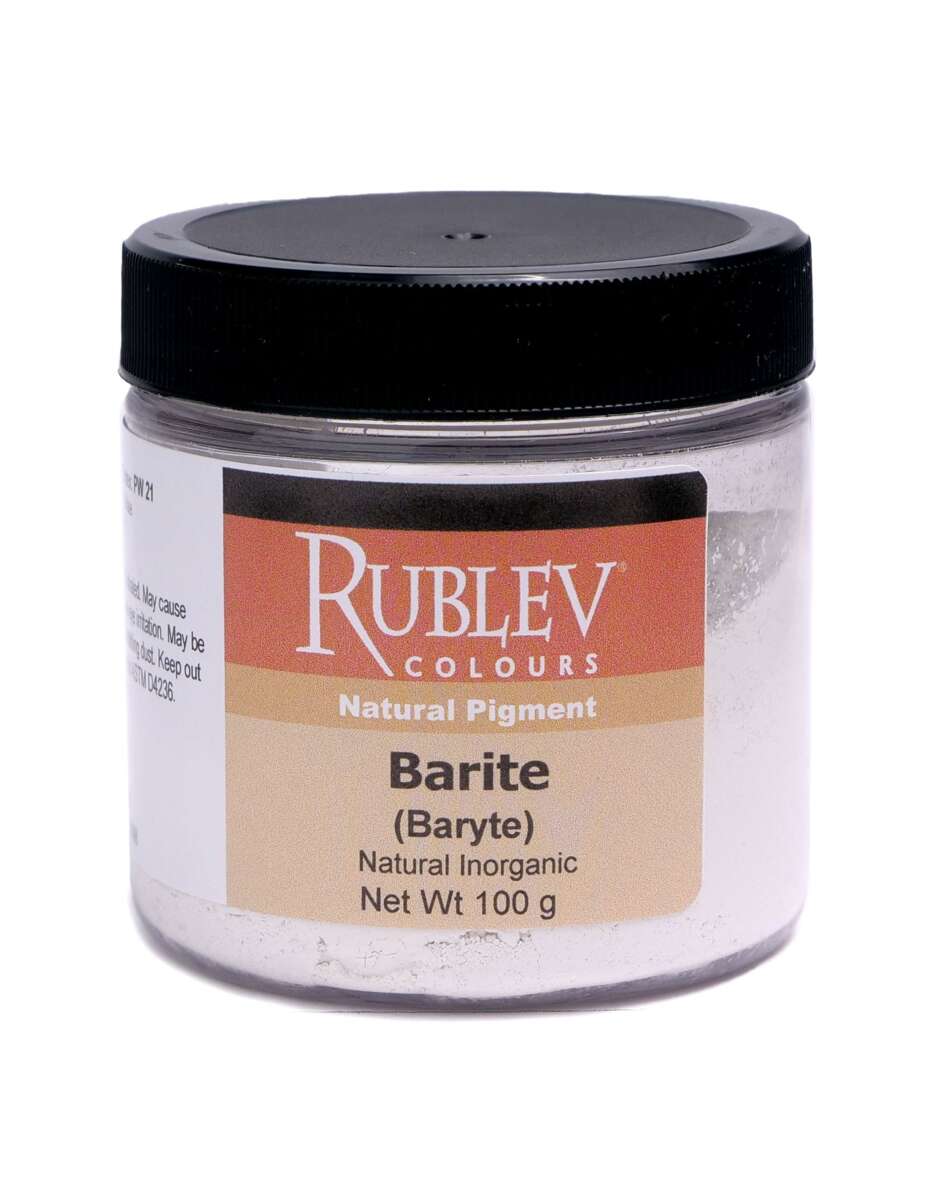Barite 100g
Rublev Colours Barite is made using the highest quality white, natural barium sulfate ore. Its fine grind (3 micron median particle size), high specific gravity (4.4) and inertness make it ideal for grounds, to make white paint and a paint filler.
Rublev Colours Barite is made using the highest quality white, natural barium sulfate ore. Its fine grind (3 micron median particle size), high specific gravity (4.4) and inertness make it ideal for grounds, to make white paint in watercolor, casein and egg tempera, and as a extender pigment in oils and alkyds.
| Pigment Names | |
| Mineral Names | English: barite, baryte, bologna stone, bolognian spar, calk, cauk, cawk French: barytite, barytine German: Baryt, Schwerspath Italian: barite Japanese: 重晶石 Russian: барит Spanish: barita Swedish: tungspat |
| Synthetic Names | English: blanc fixe French: blanc fixe, sulfate de barium German: Barytweiss, Permanentweiss Italian: sulfato de bario Russian: ланфикс баритовая сулъфат Spanish: blanco fijo |
Origin and History
Barite is a mineral consisting of barium sulfate. It is generally white or colorless, and is the main source of barium. Baryte is the British spelling and the mineral is also called heavy spar. The radiating form, sometimes referred to as Bologna Stone, attained some notoriety among alchemists for the phosphorescent specimens found in the 1600s near Bologna, Italy by one Mr. Vincenzo Cascariolo.
The name barite is derived from the Greek word βαρύς (heavy). In commerce, the mineral is sometimes referred to as "barytes." The term "primary barite" refers to the first marketable product, which includes crude barite (run of mine) and the products of simple beneficiation methods, such as washing, jigging, heavy media separation, tabling, flotation, and magnetic separation. Most crude barite requires some upgrading to minimum purity or density. Barite that is used as an aggregate in "heavy" cement is crushed and screened to a uniform size. Most barite is ground to a small, uniform size before it is used as a filler or extender, an addition to industrial products, or a weighting agent in petroleum well drilling mud.
Source
Barite commonly occurs in lead-zinc veins in limestone, in hot spring deposits, and with hematite ore. It is often associated with the minerals anglesite and celestine.& Barite is mined in Canada and Mexico and, in the United States in Arkansas, Missouri, Georgia, and Nevada. It is also prepared synthetically, called "blanc fixe," either by treating a solution of a barium salt with sodium sulfate or as a by-product in the manufacture of hydrogen peroxide.
Permanence and Compatibility
Barite is unaffected by dilute acids and alkalis. It is compatible with all pigments and in all vehicles.
Oil Absorption and Grinding
Barite absorbs 11 grams of oil per 100 grams of pigment. It readily mixes with oil and water to form a smooth paste.
Toxicity
Although barite contains a "heavy" metal (barium), it is not considered a toxic chemical by most governments because of its extreme insolubility. Care, however, should be used in handling the dry powder pigment to avoid breathing the dust.

Rublev Colours Pigment: Barite
| Pigment Information | |
| Color: | White |
| Colour Index: | Pigment White 22 |
| Chemical Name: | Barium sulfate |
| Chemical Formula | BaSO4 |
| ASTM Lightfastness Rating | |
| Acrylic: | Not rated |
| Oil: | Not rated |
| Watercolor: | Not rated |
| Properties | |
| Purity: | 98% BaSO4 |
| Specific Gravity: | 4.40 |
| Density: | 4.5 g/cm3 |
| Mohs Hardness: | 3–3.5 |
| Refractive Index: | nα= 1.634; nβ= 1.636-1.638; nγ= 1.646-1.648 |
| Median Particle Size: | 3 microns |
| Weight % Retained on 325 Mesh Sieve | 0% |
| Loose Dry Bulk Density: | 75 lbs/ft3 |
| Compacted Dry Bulk Density: | 115 lbs/ft3 |
| Weight/Solid Gallon: | 135.82 |
| Bulking Value: | 0.0279 gal |
| Oil Absorption: | 11 grams oil/100 grams pigment |
| SKU | 470-2010 |
|---|---|
| Brand | Rublev Colours |
| Vendor | Natural Pigments |
| Processing Time | Usually ships the next business day. |
| Size | 100 g jar |
| Color | White |








